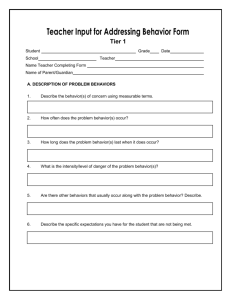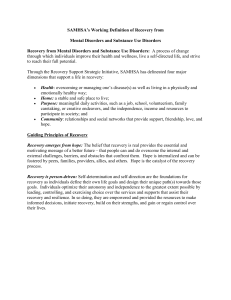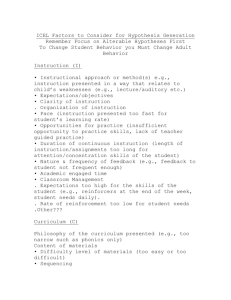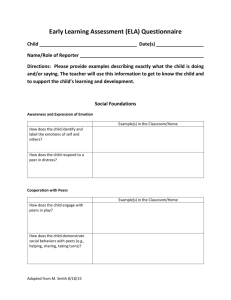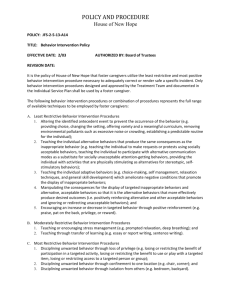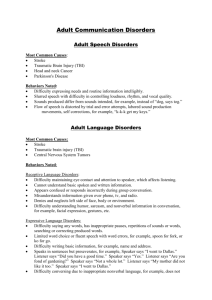ESPE_3760_-_Behavior_Disorders
advertisement
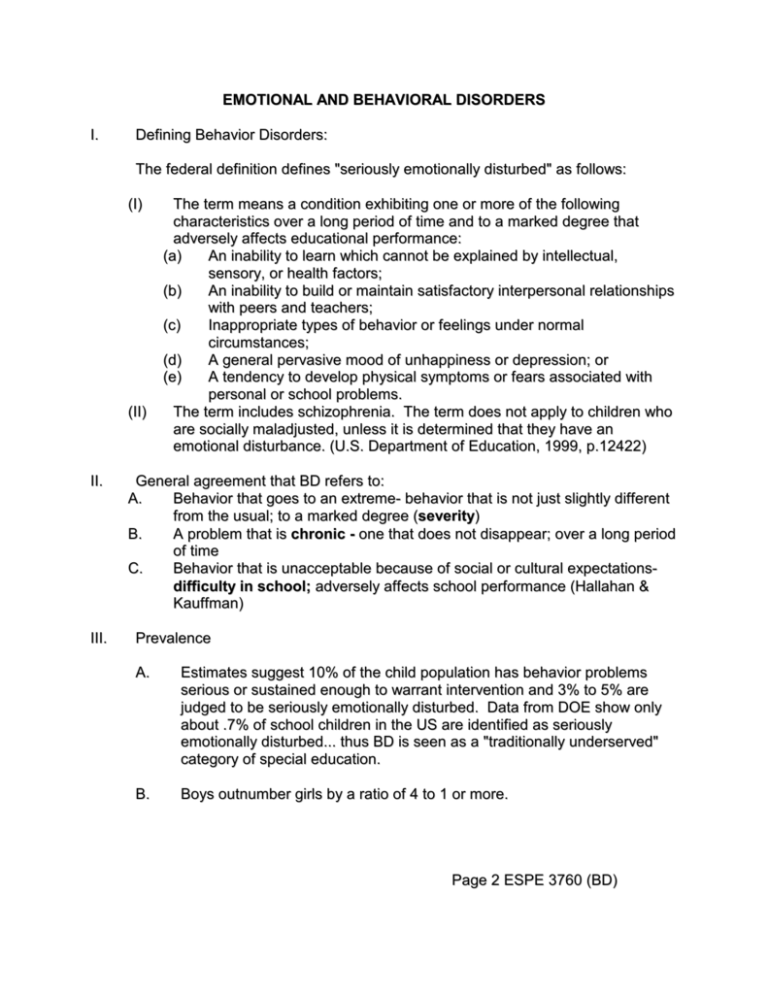
EMOTIONAL AND BEHAVIORAL DISORDERS I. Defining Behavior Disorders: The federal definition defines "seriously emotionally disturbed" as follows: (I) (II) II. III. The term means a condition exhibiting one or more of the following characteristics over a long period of time and to a marked degree that adversely affects educational performance: (a) An inability to learn which cannot be explained by intellectual, sensory, or health factors; (b) An inability to build or maintain satisfactory interpersonal relationships with peers and teachers; (c) Inappropriate types of behavior or feelings under normal circumstances; (d) A general pervasive mood of unhappiness or depression; or (e) A tendency to develop physical symptoms or fears associated with personal or school problems. The term includes schizophrenia. The term does not apply to children who are socially maladjusted, unless it is determined that they have an emotional disturbance. (U.S. Department of Education, 1999, p.12422) General agreement that BD refers to: A. Behavior that goes to an extreme- behavior that is not just slightly different from the usual; to a marked degree (severity) B. A problem that is chronic - one that does not disappear; over a long period of time C. Behavior that is unacceptable because of social or cultural expectationsdifficulty in school; adversely affects school performance (Hallahan & Ka u f f m a n ) Prevalence A. Estimates suggest 10% of the child population has behavior problems serious or sustained enough to warrant intervention and 3% to 5% are judged to be seriously emotionally disturbed. Data from DOE show only about .7% of school children in the US are identified as seriously emotionally disturbed... thus BD is seen as a "traditionally underserved" category of special education. B. Boys outnumber girls by a ratio of 4 to 1 or more. Page 2 ESPE 3760 (BD) C. IV . Causes of BD - Causes are attributed to the following major factors: A. B. V. Juveniles, who comprise about 20% of the total population, were involved in 16% of all violent crime arrests and 32% of all property crime arrests in 1999. Crimes committed by juveniles are becoming more violent and the ages of offenders younger and younger. Biological factors 1. Brain Disorders - many individuals with brain disorders experience problems with emotions and behaviors. 2. Temperment - predetermined temperment, may predispose a child to problems 3. Genetics - neurochemical imbalance, physiological causes of autism include pre and postnatal infections, chromosonal disorders, and CNS dysfunction Environmental Factors 1. Pathological family relationships (Influence of Home) - parent/child relationships, family discipline 2. Negative cultural influences (Influence of Peers)- values and behavioral standards communicated to children through a variety of cultural conditions, demands, and models. the level of violence used in the media, the availability of recreational drugs, changing sexual conduct, etc. 3. Undesirable influences of school -teachers and peers reactions to BD children, the way administration reacts - too lax, too strict, expulsion Identification A. Observations of the child's behavior and screening devices are completed by teachers, peers, siblings, parents, and often the child. These are usually in the form of some type of rating scale. If a psychologist is available, projective tests, Rorschach Ink Blot tests, and Goodenough & Harris Man/Tree tests. Observations target suspect behaviors and monitor the frequency and the duration. Page 3 ESPE 3760 (BD) B. V I. V II. IQ and Achievement- It is estimated that only 30% of students with BD are performing at or above grade level. IQ scores range between 71 and 90 with a mean IQ of 86. Most BD children are slow learners or mildly retarded. Characteristics A. externalizing - aggressive, acting out behaviors, these include the most common problems CONDUCT DISORDERS and involve: 1. hitting or fighting 2. getting out of their seats 3. yelling, talking out, and cursing 4. disturbing peers (teasing) 5. ignoring the teacher (noncompliance) 6. vandalism (destructiveness) 7. stealing and lying 8. not completing assignments B. internalizing - immature, withdrawn behavior, too little socialization with others 1. suffer from depression 2. disturbances in mood 3. inability to think 4. lack of motivation 5. decreased physical well being 6. Often these children act lonely, sad, have low self esteems, and may have difficulty sleeping, eating or eliminating. Educational Approaches A. Curriculum Goals 1. social skills - expressing feelings, avoiding fights, etc. 2. academic skills - Attempt to teach the three Rs especially since they seem to be below average on achievement. 3. Replace antisocial and maladaptive behaviors with more socially appropriate behaviors and attempt to teach more academic skills. Page 4 ESPE 3760 (BD) V III. Instructional Practices and Teacher Skills A. Use behavior management techniques such as: 1. positive reinforcement 2. contingency contracting 3. response cost 4. time out 5. token economy B. Assist child with self control or self management techniques. These should be well defined and monitored. C. Be consistent and fair. D. Document/ show student how to record daily occurences to monitor progress or determine when a change should be facilitated. E. Provide opportunities to improve social skills and improve student's self esteem. F. Show caring, empathetic feelings toward children
